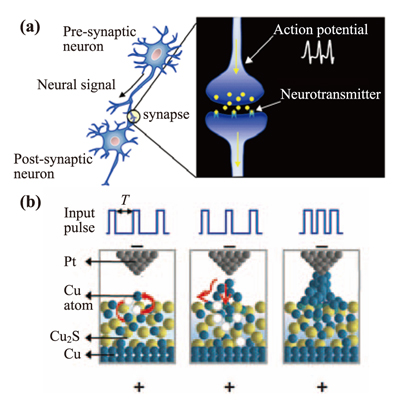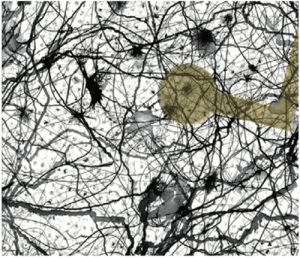 ASKING THE RESEARCHER
ASKING THE RESEARCHER
James K. Gimzewski Principal Investigator and Satellite Director, MANA / Distinguished Professor of Chemistry, UCLA
Nano-System field, Satellite PI
a Biologically Inspired Approach to Neuromorphic Computation
Atomic Switch Networks (ASN) are biologically inspired, self-organizing devices comprising of massively interconnected networks. MANA Satellite Director at UCLA, Professor James Gimzewski talks about how he discovered synaptic behavior of ASN and his path to put artificial brain into reality based on collaboration between MANA and UCLA. In between, he reveals how drones and yoga inspires him and how science has to develop in the future.
Inspired by a Brain
Professor James Gimzewski begins by saying, "There are many limitations to what a conventional computer can do." However, he adds, "the human brain is able to manage and handle very complex situations even in a very noisy and error-prone environment." In fact, scaling conventional computer to emulate the human brain has never been easy. With wires as thin as 10 nanometers being used, today's conventional computer is reaching its ultimate limit. Therefore, inspired by the human brain, Professor Gimzewski attempted to develop a device resembling synapses and neurons. "The first step actually was to build such artificial synaptic connections using something called atomic switches," states Professor Gimzewski. Incidentally, atomic switches were discovered by Professor Aono of MANA. It is a novel switching device, which works on the basis of movement of metal atoms/ions associated with their redox processes due to an applied potential.
Discovery of Synaptic Behavior of the Switch
Professor Gimzewski recalls that on a visit to MANA, he saw a young student working on atomic switch which would go on or off in a precise manner. He then asked "What happens if you just put enough energy so it's almost on or almost off?" This led them into observing the phenomenon and their data revealed that the switch "started to have a memory of the past switches." Since in UCLA, Professor Gimzewski worked on biological problems with nanotechnology, he saw a "strange connection between this atom switch behavior and a synaptic behavior." This led him to emulate properties of individual synapse in this device, and the experiment worked wonderfully.
Schematic illustration of synaptic activity.
(a) A biological synapse.
Neurotransmitters are released from a presynaptic cell when an action potential reaches it, and assist ion channels for signal transmission. Frequent stimulation by action potential results in a persistent increase in the synaptic connection.
(b) A Cu2S gap-type atomic switch with synaptic operation.
Cu2S gap-type atomic switch is constructed using a Cu2S solid electrode and a counter Pt electrode with a nanogap made between them. The Cu+ ions, which were uniformly distributed at the initial state, diffuse toward the sub-surface of Cu2S when a voltage is applied between the electrodes such that the Cu2S is at positive bias, and then precipitate to form Cu atoms on the surface due to a solid electrochemical reaction. The interval (T) of the input voltage pulse stimulation shorter, the precipitated Cu atoms form a thicker and more stable bridge between the electrodes.
Constructing Self-Assembled Network with Artificial Connections
The next summer he decided to attempt at building artificial brain by using these synthetic synapses. So, he looked at pictures of brains and neurons, especially by Santiago Ramón y Cajal, which looked like a fractal-like spaghetti connections. Another person in his group helped him to make these fractal-like structures using silver nanowires. Then the atomic switches were added by exposing it to sulfur. He then conducted series of experiments putting electrical energy through the device and watched how it behaved.
A self-assembled network of Ag nanowires
A self-assembled network of Ag nanowires coated in Ag2S with underlying Pt measurement electrodes(yellow) generates atomic switches at nanowire intersections.
Path to put Artificial Brain into Reality
ASN exhibits some characteristics that are almost identical to the human brain in terms of electrical activity. Professor Gimzewski achieved self-organization behavior with his ASN system. Self-organization is a unique behavior of human brain synapse. As a next step, Professor Gimzewski wants to "give that brain experiences and in a way observe how that brain reacts and from that reaction teach it like you would teach a child." His ASN device has managed to learn simple things and although its behavior is similar, its reaction has been non-deterministic. This is unlike a regular computer which always has the same reaction to a given input. ASN is also capable of performing machine-learning tasks such as T-maze used in understanding animal learning behavior. Similar to, say, a rat, ASN device is able to remember its path to the wall and then most of the time it does turn left (where the animal gets rewarded). Therefore, the collective interactions between these atomic switches result in unique, emergent properties that have shown significant potential for neuromorphic computing.
Developing Talents
Then, Professor Gimzewski talked about his favorite undergraduate class 'Introduction to Nanotechnology.' Students from any background can apply for this class, but they have to be very qualified. This class is very interactive. The course covers everything from esthetics to arts including looking into the future. In this regard, Professor Gimzewski says "…imagine the impossible; imagine 10 years from now, the impossible, and I make them aware also of the environment of the past technologies, of how they are unsustainable for our society." In the end, the students give their final exam by writing a book together.
Talking about his pursuits, Professor Gimzewski says he has two hobbies; flying drones and yoga. Flying drones relates intimately to his work because it has three-dimensional space involving the brain. It also gives him inspiration and he says, "It also makes me think of my brain project because eventually I would like to put it inside the drone." He also likes to do Kundalini yoga which can "modify your mind and your emotions through it." He has also started to learn Zen and says that's important not only just to be a scientist "but also to realize the importance that you are connected to everything. It's the opposite of this computer." He feels that the human mind goes on and doesn't stop at a point. In fact, he believes that "your whole body is part of your brain and the people around you and the environment around are really part of you."
Science has to Change
Pondering over the future of science, he feels that the essence of science is internationalism. That is why, the goals of California NanoSystems Institute (CNSI) in UCLA are similar to MANA in terms of developing and understanding nanotechnology for the sustainability of both countries. In the past, both countries were successful with microelectronics, but it's time for new technologies to be competitive in the global economy today. MANA and UCLA are successfully making an important contribution to each other in this context.
Professor Gimzewski, however, believes science has to change. According to him, there are three most important developments in science. First was Newton's Three Laws of Motion, which is an absolute deterministic behavior. Next is Quantum Mechanics, which says that outcomes are probabilistic, not deterministic. The last and the most important thing that science has to change is complexity. He says, "We cannot determine the future. We know that now. Everything is interconnected, not in just the Buddhist sense, but in the real sense." The world "follows laws that are nondeterministic and science has to develop a new language to deal with that. If it can, then science is very important for future, essential. If it can't, then science has failed."
James K. Gimzewski James K. Gimzewski Principal Investigator and Satellite Director, MANA / Distinguished Professor of Chemistry, UCLA
Nano-System field, Satellite PI
Prof. Gimzewski completed his Ph.D. in Physical Chemistry at the University of Strathclyde, Glasgow, Scotland, UK in 1977. After he served as a group leader at IBM Zurich Research Laboratory, he has worked as a distinguished professor of Chemistry at UCLA. From 2008, he joined MANA(NIMS) as PI Satellite Director. He was elected as a "Fellow of the Royal Society" in 2009.
 ASKING THE RESEARCHER
ASKING THE RESEARCHER



